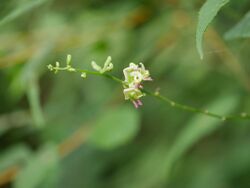Biology:Apios fortunei
| Apios fortunei | |
|---|---|

| |
| Scientific classification | |
| Kingdom: | Plantae |
| Clade: | Tracheophytes |
| Clade: | Angiosperms |
| Clade: | Eudicots |
| Clade: | Rosids |
| Order: | Fabales |
| Family: | Fabaceae |
| Subfamily: | Faboideae |
| Genus: | Apios |
| Species: | A. fortunei
|
| Binomial name | |
| Apios fortunei Maximowicz
| |
Apios fortunei, commonly known as hodo, hodoimo, groundnut, or potatobean,[1][2][3][4] is a tuber-forming member of the Bean family. It is a native plant of Eastern China and Japan.[1][2][3][4] It is one of three species in the genus Apios that are known to produce edible tubers, although it has generally been considered an emergency, or famine food or medicinal plant.[1][2][3] A study done on the chemical composition of the tubers found that starch was the predominant carbohydrate, although smaller amounts of sucrose and glucose were found and almost no fructose was found.[1] In the wild, Apios fortunei is often found near brooks.[1] Apios fortunei is a perennial climbing vine.[1][3] The leaves are pinnate with 3-7 leaflets and are ovate or lanceolate in shape, 3–7 cm long.[3] Flowers have been variously described as whitish-green, light yellowish-green with a red purple edge on the wing petal, or sulphurous green with rosy wing petals.[1][3] The flowers form pseudoracemes or terminal panicles, 6–26 cm long.[3] The flowers are showy and have ornamental potential.[1] Legume fruits are linear, 7–8 cm long and 5–6 mm wide.[3]
References
- ↑ 1.0 1.1 1.2 1.3 1.4 1.5 1.6 1.7 Seabrook, Janet E.A. (1973). A Biosystematic Study of the genus Apios Fabricius (Leguminosae) with Special Reference to Apios americana Medikus (M.Sc. thesis). The University of New Brunswick. Fredericton, Canada.
- ↑ 2.0 2.1 2.2 Kinugasa, Haruko; Yasuto Watanbe (1992). "Nutritional Composition of the tubers of American groundnut (Apios americana Medikus)". Sonoda Women's College Studies 26.
- ↑ 3.0 3.1 3.2 3.3 3.4 3.5 3.6 3.7 Hu, Shiu-ying (2005). Food Plants of China. Sha Tin, N.T., Hong Kong: The Chinese University of Hong Kong.
- ↑ 4.0 4.1 Hidemasa, Shimada. "Hodoimo America (USA Katamariimo)". http://www2.mmc.atomi.ac.jp/web01/Flower%20Information%20by%20Vps/Flower%20Albumn/ch6-foreign%20flowers/america%20hodoimo.htm. Retrieved 25 January 2014.
Wikidata ☰ Q10927658 entry
 |

